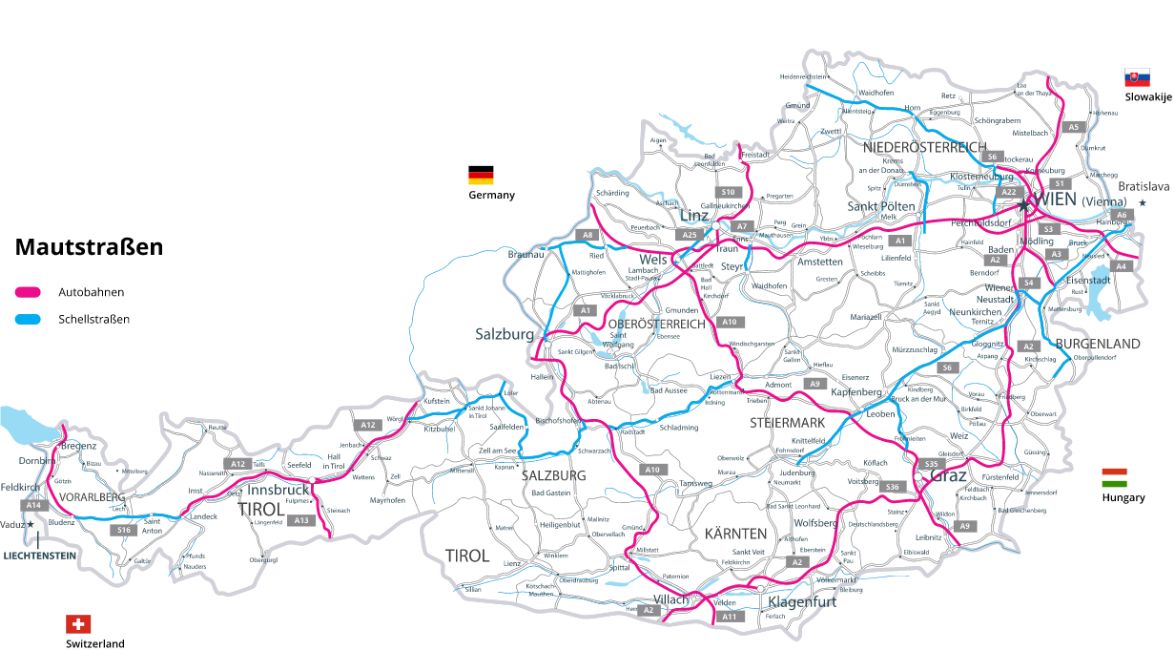Austrian Roads – The System
Austrian roads amount to a total of almost 130,000
kilometres. While it may resemble the road systems in
other countries, there are one or two differences that
travellers should be aware of.
The most important roads on which holidaymakers mainly travel are the
Austrian motorways and expressways, followed by the state roads or the
municipal roads. Additionally, there are roads with right of way or without.
What the designations are all about, how they are subdivided, and which
roads you must buy an e-vignette for in Austria will be explained in
more detail in the following article.
An overview of the
Austrian road network
As you can see from looking at the map, every region in Austria is well connected to the road network. Around cities like Vienna, Linz, Graz, and Innsbruck, there is a particularly dense network of roads. The A23 (Vienna’s Südosttangente) is the busiest urban motorway.
The road system in Austria is characterised not only by its excellent condition but also by its steady growth. Although the Austrian motorways are already almost 1800 kilometres long, they are constantly being expanded in both length and width. The same applies to the country’s expressways.

Classification of Austrian roads
The classification of the Austrian road system can be done
in two different ways: one involves subdividing the routes
based on the road traffic regulations, while the other
involves subdividing them based on the road owner. The
first option seems more familiar to most drivers. We will
explain both options in detail.
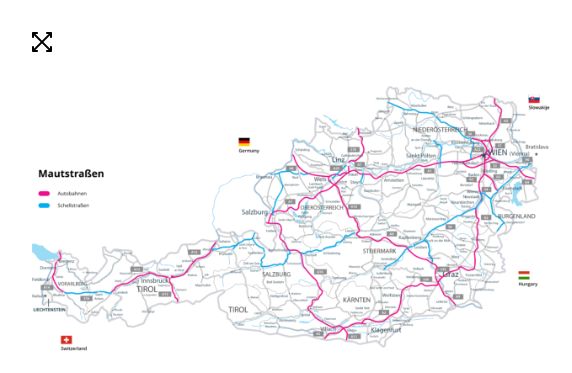
Classification according to road traffic regulations
If the classification is carried out according to road regulations, there are four different categories. The first is the locality, which delimits the towns or cities from the open roads. According to § 2 Abs 1 StVO, roads that are within a town or city are demarcated from routes outside. A stretch of road that is not located in a town or city is also called an “open country road”.
In the second category, the relevance for motor vehicles is considered in more detail. In this case, a distinction is made between motorways and roads regarding road regulations. The distinctions become clear if you look more closely at the construction of the road types. For example, lanes are not separated on roads. International traffic signs are used for both road types.
The third category refers to road names. In Austria, there are a total of 19 European roads, trunk roads that run through several countries in Europe, Central Asia, and Asia Minor at once. They exist in contrast to roads with or without the right of way.
The latter category deals with roads with the right of way in more detail. One could assume that roads with the right of way are similar to other European roads with the right of way due to the term. However, the rights that one has as a driver on the respective road sections are clearly different.
Classification according to the road owner
Another way of classifying roads is according to the road owner. As the word implies, the respective institution is responsible for the condition of the roads and must make the appropriate investments for it. On the other hand, the road owner also receives the fines collected on the respective road. The title is held by several entities, such as the country, the individual states, or the municipalities.
The responsibility of ASFINAG
In Austria, the country or the federal government is now no longer responsible for the country’s motorways and expressways. The duty was transferred to the Austrian infrastructure company ASFINAG in 1982.
Important designations - federal roads and main roads
In terms of the Federal Roads Act, motorways are also referred to as federal roads A and expressways as federal roads S. The former federal roads B are the state roads or main roads today. They are administered by the individual states and by their road maintenance departments. Municipal roads underly the administration of the municipalities.
Motorways and
expressways in Austria
The roads are marked by traffic signs with an «A» or an «S». The letters are preceded by the
name of the respective road. This is usually based on the regions in which the sections are located. The markings
provide information about which road you are on and which region you are in (for example, West Autobahn A1).
Road users are charged a user fee for driving on federal roads. This is paid via the vignette, the toll, or the Go Box. Only certain parts, such as the first section of the Westautobahn (Walserberg border crossing to Salzburg-Nord), are toll-free.
The federal roads serve as a link to neighbouring countries. For this reason, they play an important role in Austria’s road system.
Austrian motorways
There are a total of 19 motorways as defined by the StVO, most of which are in
operation. The A26 motorway in Linz is partly
under construction, but also partly still in planning.
The most important motorways and their total length
The longest motorways in the country are the A2 Süd Autobahn, which runs from Vienna via Graz to the Italian border. It is 380 kilometres long.
The A1 West Autobahn runs from Vienna to Salzburg and is almost 300 kilometres long. After the German border, it merges into the A8 motorway. Other routes that are about 200 kilometres long are the Pyhrn Autobahn A9, the Tauern Autobahn A10 and the Inntal Autobahn A12.
Obligation to have a vignette and pay tolls
As soon as you see one of the signs indicating a motorway, as a car driver, you should know that a vignette is required to use these roads. A similar principle applies to truck drivers: vehicles over 3.5 tons are equipped with a Go Box, which is used to calculate the toll on the motorways.
Austrian expressways
Of the 17 existing expressways, some are still under construction or in planning. The expressways currently boast a length of about 500 kilometres, and 700 kilometres are planned in total. In terms of the road traffic regulations, there are no expressways in Austria, which is why the sections are indicated as motorways on the signs. The similarity also becomes obvious when looking at the speed limits on the road signs.
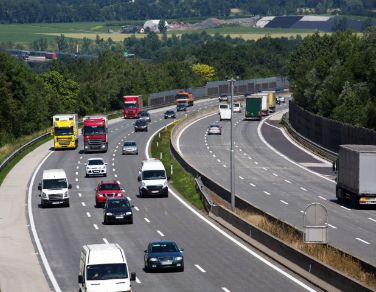
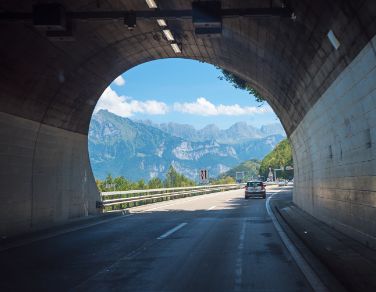
Special features: Austria’s tunnels and mountain passes
Since there are a total of 166 tunnels currently in operation and several major Alpine passes, they are also considered an important part of the road system in Austria.
The tunnel system
Many tunnels are located on the country’s motorways. For example, there are several tunnels on the Pyhrn Autobahn A9 described above. The Tauern Autobahn A10 also has several road tunnels.
The Arlberg tunnel is the longest in the country. It is located on the Arlberg expressway S16 and connects the states of Tyrol and Vorarlberg.
The tunnels are also relevant for the vignette and toll system. As they are particularly costly to maintain, a special toll must be paid for their use. The road sections are also referred to as special toll routes and are equipped with toll stations.
Pass roads - mountain passes
The most important mountain passes in Austria are the Grossglockner pass as part of the Grossglockner High Alpine Road, the Reschen pass or the Gerlos pass. These passes are considered important connecting roads to different states and countries.
There are many passes near the border triangle between Austria, Switzerland, and Italy. As far as the road system is concerned, the curvy pass roads are a special feature that exists due to the geography of the country.
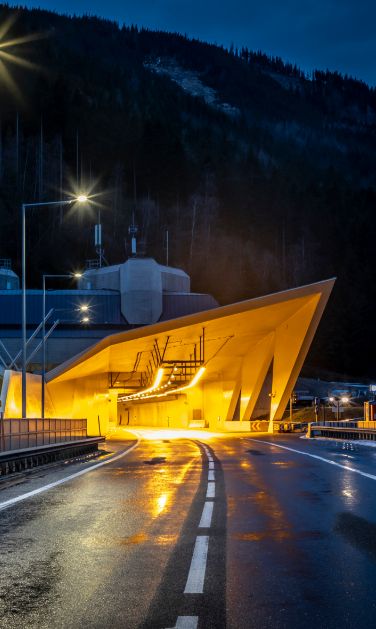
Speeds
In general, it is always advisable to pay attention to the signs on the roads when it comes to the permitted speed. According to § 20 Abs 2, the driver of a vehicle may not drive faster than 50 km/h within towns or cities and not faster than 130 km/h on motorways.
On the open country roads, the speed limit for cars and motorcycles is 100 km/h, 80 km/h with a heavy trailer, and 70 km/h for trucks.
